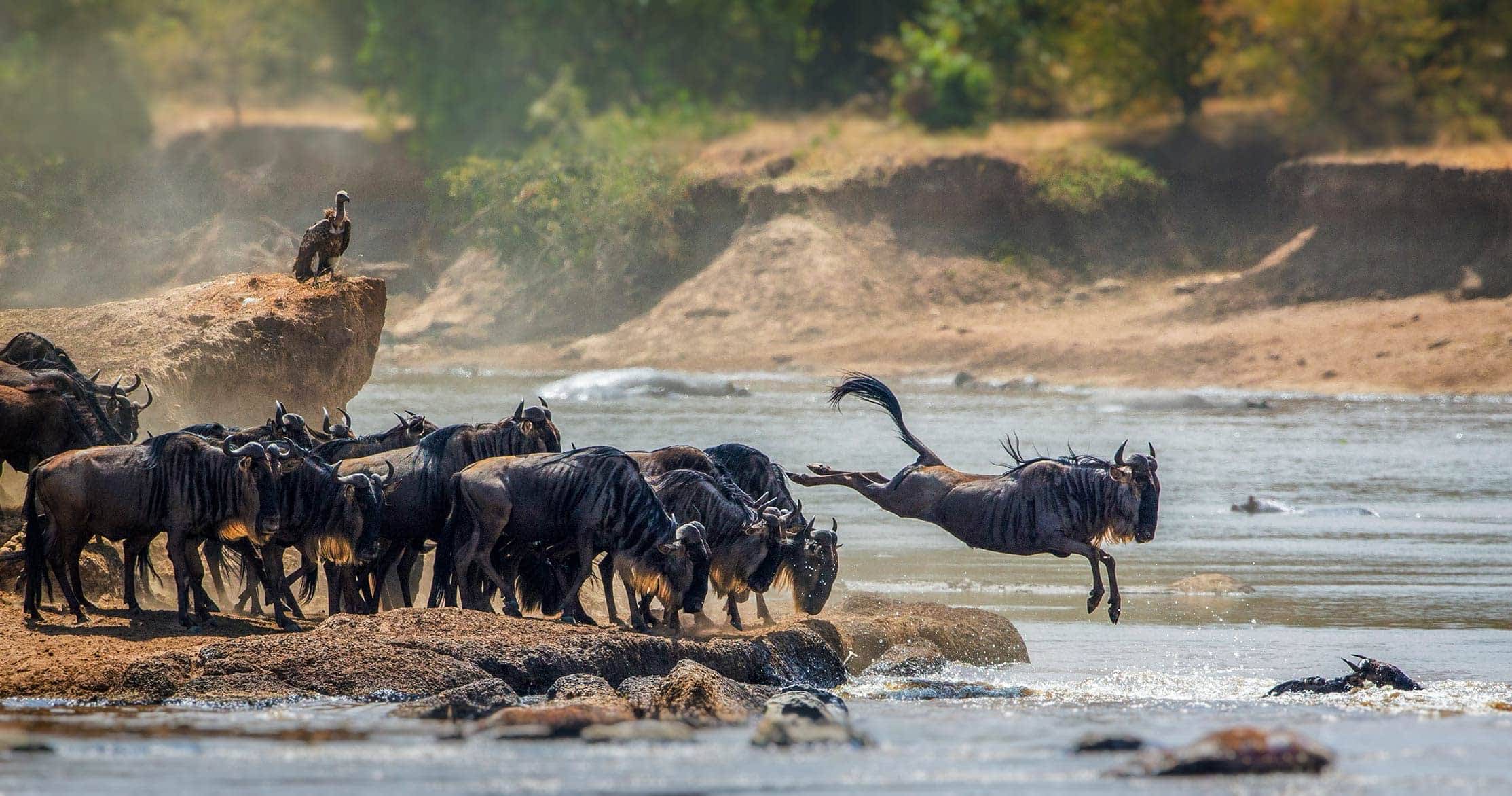SERENGETI NATIONAL PARK
Serengeti National Park, a UNESCO site, is one of the most famous and iconic wildlife conservation areas in the world. It is located in the northern part of Tanzania and spans approximately 14,750 square kilometres (5,700 square miles). The park is renowned for its incredible biodiversity and is home to a vast array of wildlife that can be seen during different incidents including the great migration – a massive movement of wildebeests, zebras, and other herbivores in search of greener pastures, followed by predators. The migration typically occurs between the Serengeti and Kenya’s Maasai Mara and is a breathtaking event to witness. Also, the park hosts the “Big Five” (lion, elephant, buffalo, leopard, and rhinoceros), as well as numerous other species such as cheetahs, giraffes, zebras, wildebeests, hippos, crocodiles, and many more.
ATTRACTIONS IN THE PARK
Serengeti National Park in Tanzania is renowned for its incredible biodiversity and stunning natural beauty. Here are some of the detailed attractions and features you can experience while visiting the park:
Great Migration
The main factor that make Serengeti national park the best destination in Tanzania and Africa at large is the Great Migration of over million wildebeests and thousands of zebras. These animals migrate from the northern hills to the plains in the south looking for the fresh grass and water of the short October rains and stay there until November. After the rains, they move to the west around river Grumeti and then to the north after the prolonged wet season of April, May, and June. This phenomenon provides excellent opportunities for witnessing dramatic river crossings and predator-prey interactions.

Birdlife
Serengeti National Park is home to over 500 bird species, making it a haven for birdwatchers. Among the bird species include the secretary bird, a lot of amazing ostriches, flamingos, vultures and eagles among others.

Other attractions in the park.
Kopjes
These rocky outcrops are scattered across the Serengeti and serve as important habitats for a variety of wildlife. They offer excellent vantage points for predators like lions and leopards, and they are also home to a range of smaller animals and birds.

Seronera Valley
This central part of the Serengeti is characterized by open grasslands and is often referred to as the “Serengeti’s Garden of Eden.” It’s a prime location for year-round game viewing, with a high concentration of wildlife, including lions, cheetahs, elephants, and giraffes.

Grumeti River
This river, located in the western part of the park, is another critical point for the Great Migration. Crocodiles lie in wait for the wildebeests and zebras attempting to cross the river, creating dramatic and intense scenes of predator-prey interactions.

Lobo Hills
Situated in the northern Serengeti, Lobo Hills offer panoramic views of the plains below. It’s an excellent area for game viewing and is known for its resident prides of lions.

Retina Hippo Pool

Located in the Seronera Valley, this is a popular spot to observe hippos lounging in the water. It’s also a great place for birdwatching, as various waterfowl and other bird species are often seen here.
Moru Kopjes

These ancient granite rock formations are located in the south-central Serengeti. They provide shelter for a variety of wildlife, and they are known for their large resident lion prides.
Maasai Rock Paintings

In the vicinity of Moru Kopjes, you can find ancient rock paintings left by the Maasai people, providing a glimpse into the region’s rich cultural history.
Sogore River Circuit

This is a great area for walking safaris (with an armed ranger) in the central Serengeti. It offers a chance to get closer to the flora and fauna and experience the park on foot.
Visitor Centers and Museums

The Serengeti has several visitor centers and museums where you can learn more about the park’s ecology, wildlife, and cultural history. Some of the notable ones include the Seronera Visitor Center and the Olduvai Gorge Museum.
Landscape

The park’s landscape is diverse, ranging from vast grasslands to woodland and savannah. There are also areas of acacia forests, rocky outcrops (kopjes), and seasonal rivers.
Serengeti Ecosystem

The Serengeti-Mara ecosystem is one of the world’s most intact and well-preserved ecosystems. It includes not only Serengeti National Park but also various adjacent protected areas in Tanzania and Kenya. This larger ecosystem is crucial for the migratory patterns of wildlife.
BEST TIME TO VISIT SERENGETI NATIONAL PARK
Dry Season in Serengeti National Park

Serengeti can be visited any time of the year; however, the dry season is the best time for game viewing experience. Late June to September are the dry seasons where you can enjoy the wildebeest migration highlight in Serengeti. However, the best time for the migration is between June and July however, the wildebeests calve from January to February.
ACCOMODATION
There are a range of accommodation options in and around the park, including luxury lodges, tented camps, and more budget-friendly campsites. These accommodations offer various levels of comfort and amenities, but all provide an opportunity to be close to the natural beauty of the park. Among these accommodations include; Serengeti Serena Safari lodge, Lobo wildlife lodge, Melia Serengeti lodge, Dunia Camp, Singita Mara River Tented Camp, Olakira migration camp, Lemala Ewanjan Tented Camp, Namiri Plains and many others.
Serengeti Serena Safari Lodge

ACCESSIBILITY
Serengeti game drive

Located in the northern part of Tanzania, Serengeti National Park is accessible by both road and air. There are several airstrips within the park, and it can also be reached by a combination of road and air travel from major cities like Arusha.
When visiting Serengeti National Park, it’s important to follow ethical wildlife viewing practices and adhere to park regulations to ensure the preservation of this remarkable ecosystem for future generations.

